 | Tom Waits
I Can't Wait to Get Off Work |
|
Chicago: May 16-17
on Police Crimes
in defense of democracy and
to end racist and political repression
Featuring Angela Davis University of Chicago
International House1414 E. 59th St, Chicago IL 60637
|
 | |
Journal of the Black Left Unity Network
|
|

New CCDS Book Reporting on Vietnam
|
 The new annual edition of our journal of discussion and analysis is now out. More than 130 pages, it includes 20 articles on organizing, racism and the right. Cost is $10 plus shipping. Or get one by becoming a sustainer. Click the title to buy it directly. The new annual edition of our journal of discussion and analysis is now out. More than 130 pages, it includes 20 articles on organizing, racism and the right. Cost is $10 plus shipping. Or get one by becoming a sustainer. Click the title to buy it directly.
|
|
Radical Jesus:
A Graphic History of Faith  By Paul BuhleHerald Press By Paul BuhleHerald Press
|

Want to Know what CCDS has
been doing...Check it Out!
|
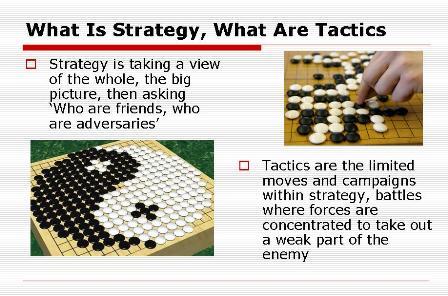 Keep On Keepin' On Keep On Keepin' OnWhy Socialists Run in Elections, Strategy and Tactics Slide Slow, Class and Privilege, the Green New Deal ...and other Short Posts on Tumblr by Carl Davidson
|

Edited by Carl Davidson Revolutionary Youth the the New Working Class: The Praxis Papers, the Port Authority Statement, the RYM Documents and other Lost Writings of SDS
Changemaker, 273pp, $22.50
For the full contents, click the link and view 'Preview' under the cover graphic.
|
|
By Randy Shannon, CCDS

"Everyone has the right to work, to free of employment, to just and favorable conditions of work and to protection against unemployment."
- United Nations Universal Declaration of Human Rights, December 10, 1948
I. Introduction
The "Great Recession" that began in 2007 has caused the greatest percent of job losses since the Great Depression of 1929. This crisis is the end of an era of unrestrained 'neo-liberal' capitalism that became public policy during the Reagan administration. The crisis marks a new level of instability with the growth of a global financial elite that targeted US workers and our trade unions after World War II.
|
|
Order Our
Full Employment Booklets
 |
...In a new and updated 2nd Edition
Capitalism may well collapse under its own excesses, but what would one propose to replace it? Margaret Thatcher's mantra was TINA...There Is No Alternative. David Schweickart's vision of "Economic Democracy" proposes a serious alternative. Even more fundamentally, it opens the door to thinking about alternatives. His may or may not turn out to be the definitive "successor system," but he is a leader in breaking out of the box. |
 by Paul KrehbielAutumn Leaf Press, $25.64
by Paul KrehbielAutumn Leaf Press, $25.64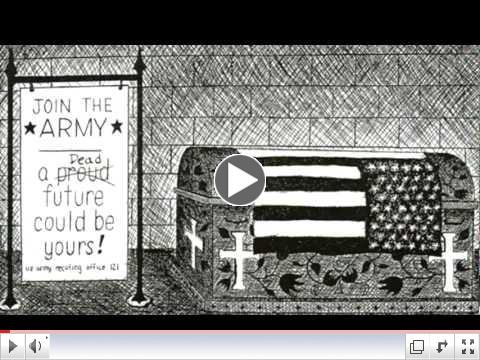 | | Shades of Justice Video: Bringing Down a President, Ending a War |
|
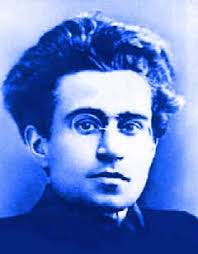 By Giuseppe Fiori
Verso, 30 pages
|

Essays on Mondragon, Marx, Gramsci
and the Green and Solidarity Economies |
Solidarity Economy:What It's All About

Edited by Jenna Allard, Carl Davidson and Julie Matthaei
Buy it here...
|

- Foreword by Susan Brownmiller
- Preface by Ken Wachsberger
$37.50 + $6 shipping
|
|
Discussion Documents for a Militant Movement
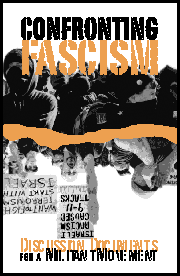
By Don Hamerquist
|
|
|
|
An Invitation to CCDSers and Friends...
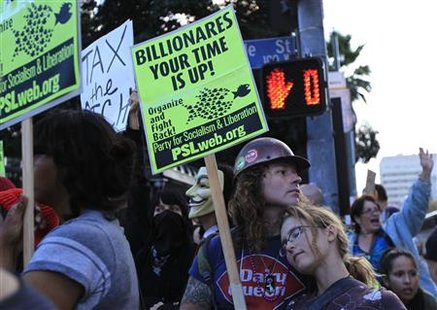 New Insurgents New Insurgents
Shaking Up City
Hall Politics
Everywhere
We're the Committees of Correspondence for Democracy and Socialism...Do you have friends who should see this? Pass it on...Do you have a blog of your own? Others you love to read every day? Well, this is a place where you can share access to them with the rest of your comrades. Just pick your greatest hits for the week and send them to us at carld717@gmail.com! Most of all, it's urgent that you oppose war on Iran, defend voter rights, plan for 2014 races now, oppose austerity, support the 'Moral Mondays' in North Carolina, the Congressional Progressive Caucus' 'Back to Work Budget'! We're doing more than ever, and have big plans. So pay your dues, make a donation and become a sustainer. Do it Now! Check the link at the bottom... |
Pittsburgh and The Revolt of the Cities
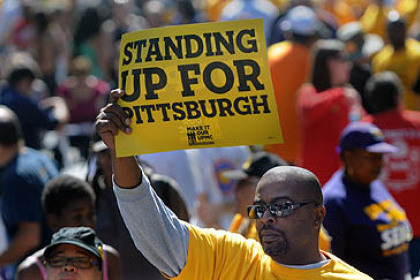
During the past 20 years, immigrants and young people have transformed the demographics of urban America. Now, they're transforming its politics and mapping the future of liberalism. By Harold Meyerson
Beaver County Blue via American Prospect
Pittsburgh is the perfect urban laboratory," says Bill Peduto, the city's new mayor. "We're small enough to be able to do things and large enough for people to take notice." More than its size, however, it's Pittsburgh's new government-Peduto and the five like-minded progressives who now constitute a majority on its city council-that is turning the city into a laboratory of democracy. In his first hundred days as mayor, Peduto has sought funding to establish universal pre-K education and partnered with a Swedish sustainable-technology fund to build four major developments with low carbon footprints and abundant affordable housing. Even before he became mayor, while still a council member, he steered to passage ordinances that mandated prevailing wages for employees on any project that received city funding and required local hiring for the jobs in the Pittsburgh Penguins' new arena. He authored the city's responsible-banking law, which directed government funds to those banks that lent in poor neighborhoods and away from those that didn't.
Pittsburgh is a much cleaner city today than it was when it housed some of the world's largest steel mills. But, like postindustrial America generally, it is also a much more economically divided city. When steel dominated the economy, the companies' profits and the union's contracts made Pittsburgh-like Detroit, Cleveland, and Chicago-a city with a thriving working class. Today, with the mills long gone, Pittsburgh has what Gabe Morgan, who heads the local union of janitorial and building maintenance workers, calls an "eds and meds" economy. Carnegie Mellon, the University of Pittsburgh, and its medical center are among the region's largest employers, generating thousands of well-paid professional positions and a far greater number of low-wage service-sector jobs.
Peduto, who is 49 years old, sees improving the lot of Pittsburgh's new working class as his primary charge. In his city hall office, surrounded by such artifacts as a radio cabinet from the years when the city became home to the world's first radio station, the new mayor outlined the task before him. "My grandfather, Sam Zarroli, came over in 1921 from Abruzzo," he said. "He only had a second-grade education, but he was active in the Steel Workers Organizing Committee in its early years, and he made a good life for himself and his family. My challenge in today's economy is how to get good jobs for people with no PhDs but with a good work ethic and GEDs. How do I get them the same kind of opportunities my grandfather had? All the mayors elected last year are asking this question."
They are indeed. The mayoral and council class of 2013 is one of the most progressive cohorts of elected officials in recent American history. In one major city after another, newly elected officials are planning to raise the minimum wage or enact ordinances boosting wages in developments that have received city assistance. They are drafting legislation to require inner-city hiring on major projects and foster unionization in hotels, stores, and trucking. They are seeking the funds to establish universal pre-K and other programs for infants and toddlers. They are sketching the layout of new transit lines that will bring jobs and denser development to neighborhoods both poor and middle-class and reduce traffic and pollution in the bargain. They are-if they haven't done so already-forbidding their police from cooperating with federal immigration authorities in the deportation of undocumented immigrants not convicted of felonies and requiring their police to have video or audio records of their encounters with the public. They are, in short, enacting at the municipal level many of the major policy changes that progressives have found themselves unable to enact at the federal and state levels. They also may be charting a new course for American liberalism.
New York's Mayor Bill de Blasio has dominated the national press corps' coverage of the new urban liberalism. His battles to establish citywide pre-K (successful but not funded, as he wished, by a dedicated tax on the wealthy), expand paid sick days (also successful), raise the minimum wage (blocked by the governor and legislature), and reform the police department's stop-and-frisk policy (by dropping an appeal of a court order) have been extensively chronicled. But de Blasio is just one of a host of mayors elected last year who campaigned and now govern with similar populist agendas. The list also includes Pittsburgh's Peduto, Minneapolis's Betsy Hodges, Seattle's Ed Murray, Boston's Martin Walsh, Santa Fe's Javier Gonzales, and many more. ...(Click title for more)
|
|
Chicago City Council's Progressive Reform Coalition To Push For $15 Minimum Wage

By Ellyn Fortino Progress Illinois
April 25 - While legislation to lift the state's minimum wage has been pending in the legislature for some time now, Chicago Ald. Roderick Sawyer (6th) said he and his fellow Progressive Reform Coalition council members are working to drum up support for a $15 minimum wage in the city.
At a minimum wage forum Thursday night hosted by Action Now's "Faith in Action" coalition in Chicago's South Shore neighborhood, Sawyer said the council's progressive caucus is looking to put forward a $15 minimum wage ordinance, though the details are still in the works.
The first step, Sawyer said, is to get more aldermen and residents involved in the discussion.
"I think (raising the minimum wage is) a basic level of respect to your constituents that are working out here hard," he told Progress Illinois. "I was at one function where a young lady worked 10 years at McDonald's and she talked about how she can't even afford the food to eat where she works. So it's frustrating, and we need to get these wages to a level where they are respectable to the citizens."
Is the mayor on board with a minimum wage hike?
"Based on what I'm hearing, he's amenable to a raise in the minimum wage," Sawyer said. "Where that level is yet, I don't know. But I'm encouraged by that, that he does understand that it should be raised. So we'll just see where it goes."
Progress Illinois asked Sawyer whether an ordinance to lift the wage floor in Chicago to $15 would have any legs in the city council at a time when lawmakers at both the state and federal levels are weighing a minimum wage hike of just over $10. The state and federal minimum wages are currently $8.25 and $7.25, respectively.
"I think we're going to try to pitch the $15 level right now, and we'll see where it takes us," Sawyer said in response.
"Hopefully, it will spread enough conversation where we can get something raised. I think we just need to press the conversation, and get (a possible wage increase) up to a level that's respectable. I think $15 is respectable. I think there's some numbers that are a little less that are also respectable, but without having some sort of benchmark, you'll never get any progress. So right now we're sticking with the $15 option."
He pointed out that Chicagoans are in support of the idea. During the March primary election, Chicago voters overwhelming supported a non-binding ballot referendum to increase the city's minimum wage to $15 an hour for employees of companies with annual revenues over $50 million. The referendum appeared on the ballot in 103 city precincts, garnering support from 87 percent of voters....(Click title for more)
|
By FishOutofWater
SolidarityEconomy.net via Daily KOS
U.S. Solar electric capacity has expanded explosively - 418% - from 2326 megawatts in 2010 to 12,057 MW in February 2014, an increase of 9,731 MW reports the U.S. Energy Information Agency. Solar has moved rapidly from a niche market to 1.13% of total U.S. capacity. To stop the rapid growth of solar, which is threatening to break Americans from the death grip of fossil fuels, the Koch Brothers are demanding to tax the sun.
U.S installed solar capacity shot up over 400% in the last 4 years.
The rapid decline in the cost of solar panels and state and federal incentives have spurred investment in solar power at all scales from individuals to small businesses to large utilities. Net metering, which allows users to reverse their power meter when they produce more power than they consume, has incentivized rooftop solar. Moreover, states from Hawaii to South Carolina have developed programs to make the installation costs affordable to average consumers. Forbes reported in July 2013 on how Gov. Neil Abercrombie and Hawaii's Democrats made solar accessible to renters. This is exactly the kind of legislation I advocated a decade earlier when I ran for a position on the board of Kauai's electric power co-op. It's great to see seeds planted finally coming up and bearing fruit.
Senate Bill 1087, which Gov. Abercrombie signed on June 27, makes solar photovoltaic systems, as well as solar thermal water heaters and big-ticket energy efficiency upgrades, available to all these underserved customers by eliminating the thorny issue of the upfront costs.
On-bill financing enables residential or commercial property owners or renters to avoid the initial out-of-pocket expense to install energy improvements. Upgrades are instead financed with loans paid back via a line item on the customer's monthly utility bill. If the property is sold or transferred, the loan stays with the meter and would be taken over by the new property owner or tenant.
But, this great progress in bringing clean energy to the individual threatens monopolists from the Koch brothers to electric utilities. The Koch's AFP have conspired with utilities to write legislation to force individuals to pay a tax to the utility companies for accessing the grid. The Koch Brother's AFP has demanded laws to tax the sun.
And damn if Oklahoma didn't just cave to the Kochs' demands. ...(Click title for more)
|
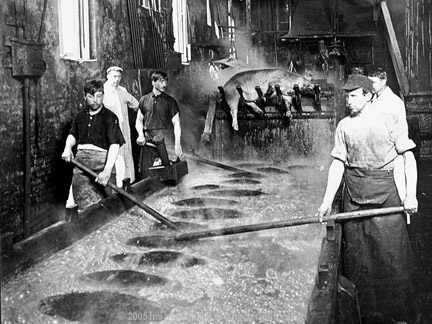
By Harry Targ
Progressive America Rising via Diary of a Heartland Radical
The stench is vomit-making as never before. The fat and plucks, the bladders and kidneys and bungs and guts, gone soft and spongy in the heat, perversely resist being trimmed, separated, deslimed; demand closer concentration than ever, more speed. A helpless, hysterical laughter starts up. Indeed, they are in hell; indeed they are the damned. Steamed, boiled, broiled, fried, cooked. Geared, meshed.
In the hog room,108 degrees. Kerchiefs, bound around their foreheads to keep the sweat from running down into eyes and blinding, become saturated; each works in a rain of stinging sweat. Almost the steam from the vats seems cloud-cool, pure, by contrast. Marsalek falls. A heart attack. (Is carried away, docked, charged for the company ambulance.) Other hearts pound near to bursting. Relentless, the conveyor paces on. ---
Slow it, we got to slow it. (Tillie Olsen, Yonnondio: From the Thirties, 1974)
American workplaces from the dawn of the industrial revolution to the recent past were living hells for workers.
Novelist and essayist Tillie Olsen described working conditions in meat-packing plants in the 1930s. Others have written about auto assembly lines, mines, textile assembly plants, and food-processing plants. Analysts such as Harry Braverman, in Labor and Monopoly Capital (1974), pointed out that employers have usually sought to control the minds and motions of workers. Profit-making has been seen as tied to controlling every movement of workers, the speed-up of production, and cutting costs for health and safety. After years of labor mobilization, the Occupational Safety and Health Act passed in 1970 to begin to address the problem of how dangerous it was to go to work each day.
Every April 28, workers across North America assemble to remember those workers who died or were injured on the job. Workers' Memorial Day, initiated in the United States by the AFL-CIO in April, 1989, celebrates the inauguration of the Occupational Safety and Health Administration (1970). Workers' Memorial Day is about remembrances, reviews of progress toward safety and health, and re-commitment to making the workplace safer.
In April, 2013 the AFL-CIO issued its annual data-based report, "Death on the Job: the Toll of Neglect," to review the current state of worker health and safety, given the administration of OSHA rules initiated over forty years ago. "Since that time, workplace safety and health conditions have improved. But too many workers remain at serious risk of injury, illness or death as workplace tragedies continue to remind us." These tragedies have occurred in mines, oil refineries, fertilizer plants, meat-packing plants, manufacturing facilities, and on construction sites.
The AFL-CIO report indicated that 4,693 workers were killed on the job in 2011 (13 workers per day). Over 3.8 million work-related injuries were reported with unofficial estimates of such injuries doubling or tripling that total. Particular sub-groups, such as Latino workers and those born outside the United States, experienced excessively high injury rates, presumably because of their fears of raising safety concerns within the workplace.
The report indicated that workplace inspections had decreased over the years because of budget constraints limiting the hiring of inspectors. Given the numbers, federal OSHA employees could be expected to investigate a workplace once every 131 years and state OSHA inspections can be expected every 76 years. Penalties for workplace violations also are inadequate to deter violations.
The Report indicated that budget allocations for OSHA must be dramatically increased, more laws must be passed to regulate the complex reality of workplace dangers, and worker rights to protest dangerous conditions at the workplace must be strengthened....(Click title for more)
|
Scary and Sad: There Are 63,000
Structurally Deficient Bridges in the U.S.

By Laura Clawson Daily Kos Labor
It's better when our bridges don't collapse.
There are 63,000 structurally deficient bridges in the United States. Let that sink in for a minute.
Then ask yourself: How is this not seen as a national scandal? After all, even though "structurally deficient" doesn't necessarily mean "likely to collapse tomorrow," we have seen some major bridge collapses in recent years, and 63,000 is a lot of bridges. Collectively, these bridges are crossed 250 million times a day. So again, why is this not something the government is aggressively working to fix? Oh, wait:
With an ample boost in federal money, $100.2 billion was spent by governments on all levels in 2010 on capital improvements for the nation's 604,493 bridges and 4.1 million miles of roads.
That sort of spending brought progress in the first decade of the 21st century, leading to a slight decline in the number of deficient bridges.
But with much of the nation's post-World War II infrastructure wearing out and the federal gas tax that built it steadily declining, experts say more than 1 trillion dollars of investment is need to shore it up.
That's right, it would require the government spending money to bring 63,000 bridges up to standard. Therefore, not only does it not rank at the top of the Republican priorities list, it's almost seen as some kind of outrage to suggest, even though it would be a major job creator. You don't put $1 trillion into bridges without taxing someone, after all, and low taxes rank well above jobs on that Republican priorities list. Hey, maybe if Republicans cut our taxes enough, we'll be able to afford rowboats for when bridges become a weird 20th-century anachronism.
In the shorter term, the American Road and Transportation Builders Association suggests posting signs identifying bridges as structurally deficient. That's a great idea-want to bet politicians would get a lot more pressure on this issue if every time anyone crossed a structurally deficient bridge, they passed a sign labeling it as such?...(Click title for more)
|

By Teresa Cheng
Labor Notes
April 23, 2014 - The strike at the Yue Yuen shoe factory in Dongguan, China, keeps growing: now 48,000 workers have joined. Activists are asking international supporters to leaflet stores, and to send workers encouragement via the Facebook and Twitter hashtag #ChinaSolidarity.
The strike at the Yue Yuen shoe factory in Dongguan, China, keeps growing. Now 48,000 workers have joined, and local groups are calling for international solidarity.
Labor activists at the site, in touch directly with the workers, are asking supporters to target Adidas and Nike and demand they negotiate directly with the workers.
Yue Yuen, owned by Pou Chen Group, is the largest athletic shoe manufacturer in the world.
Workers began striking April 5 after finding out that the work contracts they had been signing with the company were fake, and that the company had been significantly underpaying their social insurance for nearly 20 years.
Some workers are preparing to retire and have been robbed of the social insurance funds they are legally entitled to. The total amount workers are owed in back pay from the underpayment has not been calculated-but at the very least it is in the millions.
Faced with the company's stubbornness and piecemeal offers, more and more workers have joined the strike-and it ballooned to include a solidarity strike by workers employed by the same company in neighboring Jiangxi province.
Heightened Surveillance
Despite heavy surveillance and cops stationed all around, workers remain in the industrial park. Communication continues through new and dispersed QQ (social media chat) groups, and in areas where workers naturally assemble: by the river, clocking in and out, and at rest areas inside the plant.
Many of the worker activists and some reps have been arrested. It is unclear who has and hasn't been released. Zhang Zhiru and Lin Dong, both with the ChunFeng ("spring wind") worker center, are among those whose whereabouts are unknown. They were instrumental in providing guidance and advice to workers about collective bargaining and formulating demands.
Bus Strike
Meanwhile, thousands of drivers for a private bus company held a strike and protest in Shenzhen April 22, "demanding a more transparent wage calculation system, overtime payments in arrears, fewer working days, and the abolition of a penalty scheme that forced drivers to pay for any vehicle damage caused by accidents or face dismissal," China Labor Bulletin reports.
A 50-year-old driver described the conditions: "Human beings just cannot stand these long shifts and heavy workload. Imagine getting up at six in the morning and coming home after ten at night, driving 320 kilometres [200 miles] across five districts, stopping at over 100 traffic lights and 60 stations, and still having to worry about earning a living wage. On top of that, your shift for tomorrow is one hour earlier!"
The next day, "company representatives were dragging workers out of their dormitory and forcing them back to work," reports CLB.
There are no formal worker representatives currently. The All-China Federation of Trade Unions has set up a working group and is doing an investigation in the factory, but the results are not expected to be made public.
Meanwhile, local groups are doing their best to communicate with workers and identify leaders-all very challenging with the heightened surveillance.
So far workers have rejected all management's proposals: a minimal wage increase, a housing allowance, and a new social insurance payment scheme.
Solidarity Requested
Hong Kong groups closest to the action believe that, if the workers hold out, they can win by going after the source of power and money: the brands.
The groups are asking international supporters for two things:
Pressure on Adidas and Nike. Letters from U.S. unions targeting these brands would be very helpful. Supporters also plan to leaflet customers outside Adidas stores in Taipei, Melbourne, London, and several U.S. cities this week. Click here to locate a store near you and download leaflets. Here's info for an April 24 action in New York City.
Solidarity messages encouraging workers to keep on with the strike. American consumers should take pictures with signs saying they support Yue Yuen workers. The best way to post solidarity messages and photos is to post them to your own Facebook page and using the hashtag #ChinaSolidarity. This will allow Hong Kong supporters to find them and forward them to workers' social media groups. If you're not on Facebook, email them to teresac710@gmail.com.
The goal is direct negotiations between the workers and the companies and brands, with some Hong Kong worker center representatives sitting in as observers. ...(Click title for more)
|
By Stephanie Zacharek
Village Voice
April 23, 2014 - The Venn diagram overlap of Shakespeare with the elaborate scrap-fabric quilts pieced together by early American settlers is Orson Welles's Othello, a film pulled together from everything and nothing. This Othello took nearly four years to make: Welles began planning it in the summer of 1948, and it debuted at Cannes in 1952.
It was filmed in fits and starts, in at least four locales in two countries, as Welles's finances were alternately drained dry and replenished. Several Desdemonas came and went. Because so much of the movie had been shot on the fly, at different times in different places by different cameramen, Welles assembled it largely in the editing room, cleverly stitching one sequence to the next to impart the illusion of continuity. Othello came together in defiance of any unifying principle beyond the scrappy vision of its director. It's a work of seat-of-the-pants grandeur.
Welles's Othello is so intimidated by women that he'd rather avoid them.
Even if Othello isn't one of Welles's greatest films - on my own list, it would trail The Magnificent Ambersons, Touch of Evil, and Citizen Kane - the stark beauty of its compositions alone make it a standout. Welles locates the humanity in Shakespeare's characters by finding the proper visual setting for each: A rejected wife is dwarfed by the vast, chilly emptiness of the marital bedroom; an embittered underling schemes and fumes as sinister black flags ripple in the wind around him, as ragged and tatty as the hair of witches. How did Welles take such a seemingly delirious clash of visual patterns - the slender, pointed windows of Venice, the all-work, no-play parapet of a mighty Moroccan fortress, the vertigo-inducing swirl of mosaic tile floors, and more varieties of iron grillwork than you'd think mankind could dream up - and synthesize them into such an expressive, visually vibrant whole? That's one of the great mysteries of Welles's genius, and a splendid new, velvety-crisp restoration of Othello at Film Forum (through May 8) is as good an excuse as any to bask in it.
As Welles himself noted in a wiggy ramble of a documentary he made in 1978, Filming Othello, the love story at the heart of this adaptation isn't that between the jealous Moor, Othello (played by Welles), and his young white bride, Desdemona (the luminous but stiff French-Canadian actress Suzanne Cloutier). It's Othello and his duplicitous lieutenant, Iago (Micheál MacLiammóir), who share the strongest bond. Othello warms to Iago's counsel, eagerly buying the wretch's pure and inexplicably evil malarkey. Yet when his wife asks him to pardon the right-hand man he's dismissed for drunkenness and disorderly conduct (Cassio, played as a big blond galoot by Michael Laurence), Othello barely seems to hear her. Cloutier's Desdemona is a pitiable creature, all right, but she's too wispy to hold our attention. Welles, rather than stressing the dark-skin, white-skin contrast of this interracial marriage, sets his Othello in a man's world, where women are ornamental, and necessary to a degree, but men are more interesting to listen to. ...(Click title for more)
|
|

The Communist Horizon
By Jodi Dean
Verso, London and New York,
2012.192pp., £12.99 hb
Reviewed by Jule Ehms
Marx & Philosophy Review of Books
Jule Ehms just received her master's degree from Martin-Luther-University Halle (Germany) in philosophy. She is working on Marxist epistemology and philosophy of science (jule.ehms@gmail.com).
Jodi Dean's Communist Horizon wants to reintroduce communism as a serious political alternative to the American left. Although Marxists will probably have some problems with Dean's conceptions, for the unconvinced activist or sceptical student this book offers interesting insights in the current political landscape.
According to Dean the idea of communism can currently be associated with six aspects: (1) the specific image of the Soviet Union (including the dictatorship of Stalin and the collapse of 1989), (2) communism as a present, increasing powerful force, (3) as the sovereignty of the people, (4) with the role of the common and the commons, (5) communism as the egalitarian and universalist desire, which could liberate the current left from its melancholy and (6) the communist party. To each of these features Dean devotes a single chapter. But unfortunately she neither clarifies where her conception is actually coming from nor does she provide a more concrete explanation of what communism could mean - at least an explanation which would extend the phrase 'from each according to ability, to each according to need' (15).
In the first two chapters Dean discusses the usual misconception of communism by conservatives and criticizes the left as not having 'the communist horizon' either. According to her a concrete agenda is currently missing and would result in a left only active in order to defend the status quo. Stating that 'the left' should not be afraid of returning to a more radical stance, Dean truly formulates an important critique. However, it is not obvious who is meant by 'the left'. Marxist or socialist activists who actual do exist and do important political work, seem to be completely overlooked by Dean's analysis.
In chapter three the concept of communism as a political idea - the sovereignty of the people - is discussed. Here Dean wants to explain (and to mitigate) what was usually expressed by the slogan 'dictatorship of the proletariat'. She first replaces the antagonism of proletariat and bourgeoisie with the antagonism between the rich and 'the rest of us'. This change of concepts has indeed the advantage that the division among the classes is no longer a question of the access to the means production (which is a complicated issue in a service society), but becomes a question of the standard of living. Unfortunately, however, substantial features of Marx's economic theory are lost in the process.
Dean then discusses the idea of sovereignty. She rejects the term `dictatorship' since it only occurs in the context of the state withering away after the proletariat has taken over the means of production and therefore also political control. For the author the idea of communism is compatible with the institution of a state. For most Marxists, however, the state expresses the domination of one class over 'the rest of us'. If Dean wants to hold on to the idea of the state she should therefore explain what she understands by this.
With Chapter three the book suddenly becomes more complex, partly because Dean goes into the political theories of Michael Hardt, Antonio Negri or Michel Foucault. Moreover the reader is also confronted with concepts of psychoanalytic discourse, especially those of Jacques Lacan, which might be challenging for the unprepared reader.
Chapter four returns to the current state of affairs and Dean introduces the concept of 'communicative capitalism' in order to describe it. The actual state of capitalism is characterized by what Dean calls an 'ideological formation': the combination of capitalism with democracy via networked communication technologies (123). She focusses hereby on 'the common' as what is shared by a community and how this - as the social substance - gets exploited and expropriated. Dean again offers some pertinent observations of some of the problems of leftist activism and, for example, criticizes the way the real potential of political critique gets lost in the use of social media. However, her reflections also involve a too loose approach to the terms `exploitation' and `value', which were originally meant to describe concrete economic relations. Additionally it would have been helpful if Dean had specified how she understands democracy. If communism offers the ideal conditions for the self-determination of the people, how do we speak about democracy in the context of the bourgeois state? ...(Click title for more)
|
Greet May Day 2014 With a Red Resolution...
Become a CCDS member today!
 The time is long past for 'Lone Rangers'. Being a socialist by your self is no fun and doesn't help much. Join CCDS today--$36 regular, $48 household and $18 youth. The time is long past for 'Lone Rangers'. Being a socialist by your self is no fun and doesn't help much. Join CCDS today--$36 regular, $48 household and $18 youth.
Better yet, beome a sustainer at $20 per month, and we'll send you a copy of Jack O'Dell's new book, 'Climbing Jacobs Ladder,' drawing on the lessons of the movement in the South in the 1950s and 1960s.
Solidarity, Carl Davidson, CCDS
|
|
|